|
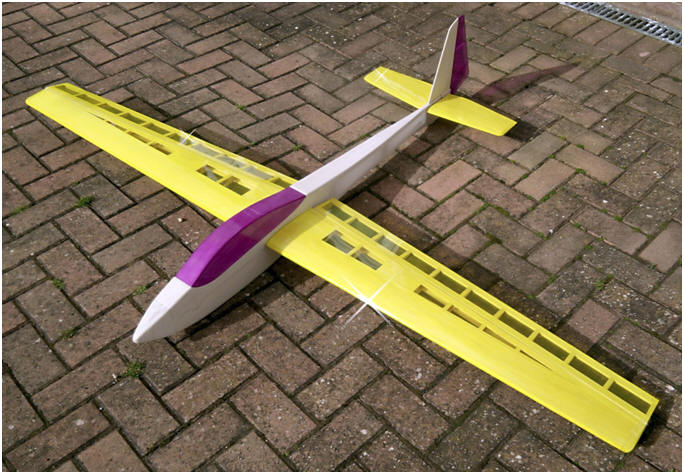 No
sorry, not this Ferengi with a lust for profit and Gold-Pressed
Latinum, nor any one of the six types of sub-atomic particles known
as Quark flavours; up, down, strange, charmed, bottom and top. In
fact, this Quark flavour, the 2M, is a lightweight aerobatic soarer
for VTPR* or close-in slope manoeuvres from Fred Marie in Ireland. No
sorry, not this Ferengi with a lust for profit and Gold-Pressed
Latinum, nor any one of the six types of sub-atomic particles known
as Quark flavours; up, down, strange, charmed, bottom and top. In
fact, this Quark flavour, the 2M, is a lightweight aerobatic soarer
for VTPR* or close-in slope manoeuvres from Fred Marie in Ireland.
This QUARK balsa model
comes as a part-kit, a design by Fred Marie whom
I believe is a Frenchman; the model certainly looks like a French
VTPR type with a bulbous front end. The kit is all wood except for a GRP bellcrank. All the
parts for the fuselage, wings, rudder and elevator are laser cut
from balsa and lite-ply. However, you will need some sheet balsa and
wing tubes and dowels plus hinges, clevises etc. to complete the
model.
The two plans and instructions supplied refer to different
iterations of the model, I believe, which can be confusing as one recommends a
1m carbon tubular spar in each wing while the plans only show a
shorter carbon wing dowel tube with spruce or balsa spars. I balked
at the cost (£30+ inc.pp) of a 2 metres of carbon tube and carbon
rod as wing dowels so I chose 10mm aluminium tube and a short piece
of 8mm diameter carbon rod for the main dowel with a smaller pieces
of 6mm carbon rod and ally tube for the locating dowel which I
already had.
 WINGS WINGS
The wing construction is
straightforward, and because the wing ribs are laser cut, the parts
lock together tightly to make a light but seemingly strong wing. The
wing can be part or wholly sheeted. The ailerons and wings are
built-up separately and, like the fuselage and tail pieces, have
lightening holes to save every gram. The finished 2M model can come
out as light as 1.2kg but I had no way of knowing its final weight
until it was balanced. I intended to use a mix of Solartex
for the fuselage and transparent film for the surface covering, I
already had servos for the two ailerons, rudder and elevator (HS82MG
for the wings and HK* GoTeck) from other models. I considered
using a pair of Samsung 18650 or 4 Eneloop Pro cells
for the power supply, it depends on the balance and CG; I chose a
new cell (to me) as it happens.
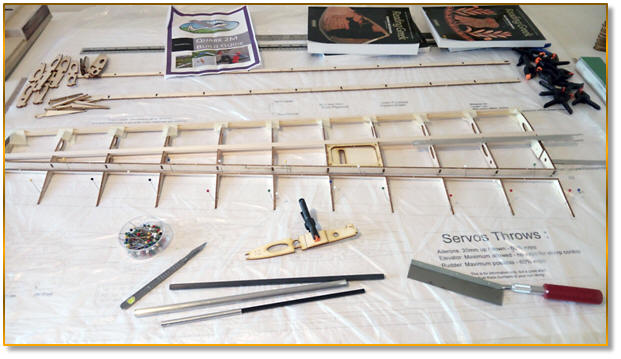 Both the wing and tailplane are
built upside down and the ribs have lugs to support the inverted
surfaces as they are built, these are cut off later when the topside
of the wing is sheeted. Aiming to keep this model very light I chose
a balsa spar with vertical double shear webs each side of the spar
for the wings, the wing dowel is 8mm carbon tube in a 10mm aluminium
tube. One wing panel done
(and now up the right way) it just needs a little sanding then the
HS82 servo can be installed and the panel covered with film. There
are no flaps on this model only large 3” wide strip ailerons.
Designed with a built-in chamfer the leading edge of the aileron
really means that the wings have to be tape hinged on the top
surface. I chose to use Blenderm tape which, primarily
intended for skin wounds, is very sticky and quite flexible. This tape is
available from many pharmacies I should think, although I bought
mine from HK. The two panels came out at just 172g each
before final sanding, servos and covering which bodes well for a
lightweight model. Both the wing and tailplane are
built upside down and the ribs have lugs to support the inverted
surfaces as they are built, these are cut off later when the topside
of the wing is sheeted. Aiming to keep this model very light I chose
a balsa spar with vertical double shear webs each side of the spar
for the wings, the wing dowel is 8mm carbon tube in a 10mm aluminium
tube. One wing panel done
(and now up the right way) it just needs a little sanding then the
HS82 servo can be installed and the panel covered with film. There
are no flaps on this model only large 3” wide strip ailerons.
Designed with a built-in chamfer the leading edge of the aileron
really means that the wings have to be tape hinged on the top
surface. I chose to use Blenderm tape which, primarily
intended for skin wounds, is very sticky and quite flexible. This tape is
available from many pharmacies I should think, although I bought
mine from HK. The two panels came out at just 172g each
before final sanding, servos and covering which bodes well for a
lightweight model.
FUSELAGE
In
between cutting, gluing, pinning and waiting the second wing panel,
now going faster after the first one, I removed the parts for the
fuselage and laid them on the plan. The fin and rudder fit nicely
and, as you can see, the fuselage is a bit of a jigsaw puzzle of ply
and balsa presumably because the parts need to fit in a certain size
box for the Irish post. All straightforward and with the massive
plan on the floor, it looks easy to assemble and it is light. As I build, I am
thinking this 2M model could come out at under 1kg. I did make one
modification to the original model and that is in the nose. The nose
block is made by sandwiching together the eleven pieces of balsa and
ply supplied and then sanded.
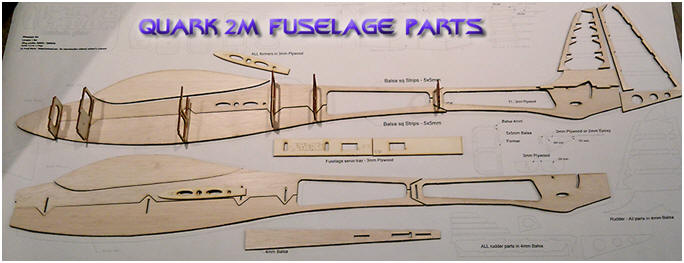 |

|
|
Reasoning that the model would probably need nose weight I cut some of these pieces to create a
void in the nose block before gluing that would take a 100g+ chunk of lead as far forward as possible, if it were necessary. |
|

FIN & RUDDER
The fin and rudder are simplicity
itself and meant to be light; this is the framework but the fin
needs sheeting with 1/32” balsa (like the tailplane). The fin has a
carbon tube on the hinge line fixed into fuselage to make it a
bit stiffer and more rugged. I used 0.8mm obechi veneer as I had
insufficient 1/32” balsa. It will have pull-pull cables. The tailplane halves proved
trickier than I first thought since the pre-cut ribs for it are very
delicate... I broke a couple. I could not find the correct size
carbon rod and a tube to fit so I used different sizes to those on
the plan. I sheeted with 1/32” balsa on the top and 1/32” obechi on
the bottom.
Before covering, they came out at just 22g for each half
and light enough I thought. I used two flanged ball races on the
fuselage for the rotating pivot; a change from the plan. I used
incredibly shiny clear film (backing film very hard to remove) from
HK… I bought a 5 metre roll for less than £7!!! It seems to work
well enough, better than the old Solarfilm in some ways. I made a
regular balsa pushrod, btw. |
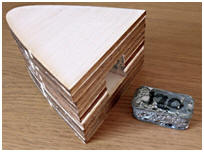 |
ELEVATOR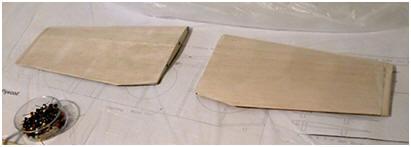
I did suffer a little ‘builder
fatigue’ as I call it, as I thought about a Mad Stab*, tried it and
failed, so progress was slow. I added a couple of cheap aluminium
cased servos from HK for the elevator and rudder and I used a pair
of old HiTec 82s from another model for the wings. I used four
Duracell Ultra NiMH rechargeable cells (new to me) as the power
supply. Rated at 2500mAh they are a change from the more expensive
Eneloop Pro I normal use (these Duracells cost about £8 for 4AA).
When I finally finished the Quark
2M I had gone overweight, I missed my 1kg target. The 172g nose
weight that I added didn’t help. The A.U.W. was 1.166kg. This
equates to a wing loading of 30.7 g/dm2, almost exactly
10oz/sq.ft. |
|
Not everything
went according to plan, my building skills have deteriorated over
the years! This model finishes my 2018 winter building. I started by
re-furbishing my 2.7m Jedi aerobatic from France… and pressing a new
pair of wings for it, then it was this Quark. All that remains
is to fly both of them. One heavy and one light, I have a feeling my
favourite models will still be my Kinetic and my Raptor though. |
-
Quark ‘Flavours’
-
Span: 2m
-
Length: 1,40 m
-
Surface AREA: 38 dm²
-
Wing Profile: SB96V/SB96VS
-
Weight 1,2 - 1,7 kg
-
VTPR =
Voltige Très Près du Relief
-
Mad Stab: +/- 90º
movement
-
HK: HobbyKing.com
-
Fred Marie:
www.islandmodels.ie
|
 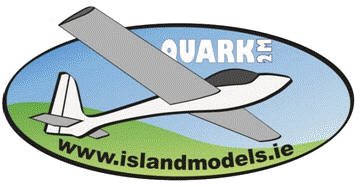 |
 |
|
|


 No
sorry, not this Ferengi with a lust for profit and Gold-Pressed
Latinum, nor any one of the six types of sub-atomic particles known
as Quark flavours; up, down, strange, charmed, bottom and top. In
fact, this Quark flavour, the 2M, is a lightweight aerobatic soarer
for VTPR* or close-in slope manoeuvres from Fred Marie in Ireland.
No
sorry, not this Ferengi with a lust for profit and Gold-Pressed
Latinum, nor any one of the six types of sub-atomic particles known
as Quark flavours; up, down, strange, charmed, bottom and top. In
fact, this Quark flavour, the 2M, is a lightweight aerobatic soarer
for VTPR* or close-in slope manoeuvres from Fred Marie in Ireland. WINGS
WINGS Both the wing and tailplane are
built upside down and the ribs have lugs to support the inverted
surfaces as they are built, these are cut off later when the topside
of the wing is sheeted. Aiming to keep this model very light I chose
a balsa spar with vertical double shear webs each side of the spar
for the wings, the wing dowel is 8mm carbon tube in a 10mm aluminium
tube. One wing panel done
(and now up the right way) it just needs a little sanding then the
HS82 servo can be installed and the panel covered with film. There
are no flaps on this model only large 3” wide strip ailerons.
Designed with a built-in chamfer the leading edge of the aileron
really means that the wings have to be tape hinged on the top
surface. I chose to use Blenderm tape which, primarily
intended for skin wounds, is very sticky and quite flexible. This tape is
available from many pharmacies I should think, although I bought
mine from HK. The two panels came out at just 172g each
before final sanding, servos and covering which bodes well for a
lightweight model.
Both the wing and tailplane are
built upside down and the ribs have lugs to support the inverted
surfaces as they are built, these are cut off later when the topside
of the wing is sheeted. Aiming to keep this model very light I chose
a balsa spar with vertical double shear webs each side of the spar
for the wings, the wing dowel is 8mm carbon tube in a 10mm aluminium
tube. One wing panel done
(and now up the right way) it just needs a little sanding then the
HS82 servo can be installed and the panel covered with film. There
are no flaps on this model only large 3” wide strip ailerons.
Designed with a built-in chamfer the leading edge of the aileron
really means that the wings have to be tape hinged on the top
surface. I chose to use Blenderm tape which, primarily
intended for skin wounds, is very sticky and quite flexible. This tape is
available from many pharmacies I should think, although I bought
mine from HK. The two panels came out at just 172g each
before final sanding, servos and covering which bodes well for a
lightweight model. 







